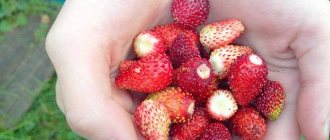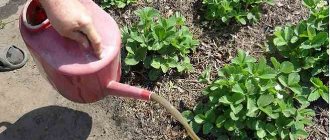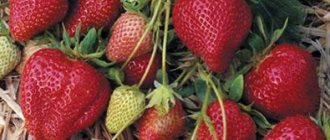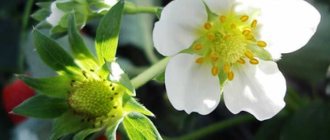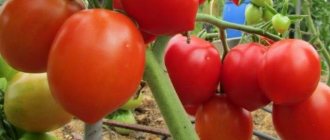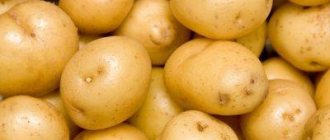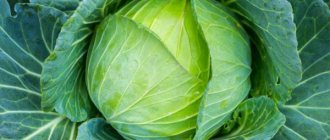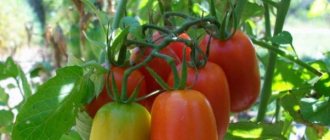Description
The bushes of the remontant strawberry variety Rügen are compact, semi-spreading, one might say, spherical. The height of the plants is about 18 cm. On erect peduncles located at the same level with the foliage, the berries always remain clean. Strong inflorescences do not lie on the ground.
Strawberry leaves are medium-sized, juicy green, with clearly visible corrugation, as in the photo.
The berries are small, conical, without a neck. The length of strawberries of the remontant variety Rügen is from 2 to 3 cm, in the thickened part about 1.2-2 cm. The mass of shiny fruits is 2-2.5 g. The surface of the berries is a rich, intense red color. The coloring of Rügen berries is uniform. The seeds are located on the surface.
Rügen strawberries taste like wild berries: sugary, sweet, aromatic. The pulp is dense and juicy. The purpose of the variety is universal, suitable for compotes, jams, jams, freezing and making desserts.
The agricultural firm Aelita supplies Russian gardeners with seeds of the remontant strawberry Rügen.
Advantages and disadvantages of the variety
One description is sometimes not enough to decide on the choice of strawberry variety. Gardeners are interested in the advantages and disadvantages of varieties. Everything related to Rügen strawberries can be found in the table.
| pros | Minuses |
| Early ripening. | Does not grow well in unimproved areas. |
| Excellent taste. Berries are useful because they contain a large amount of iron. | The variety is demanding on watering and fertilizing. |
| High yield. | Plantings need to be rejuvenated after three years. |
| Long fruiting until frost. | |
| No mustache is formed, the plantings do not thicken. | |
| Winter hardiness, can withstand temperatures down to -25 degrees. | |
| Unpretentiousness. | |
| Resistance to many crop diseases. | |
| High transportability and long-term storage. |
Remontant small-fruited varieties of garden strawberries:
Reproduction methods
Remontant varieties reproduce in the same way as ordinary garden strawberries and strawberries. Let's take a brief look at the different options.
Attention! The remontant strawberry variety Rügen does not form whiskers, so new plants cannot be obtained this way.
Dividing the bush
You can divide the bush of wild strawberry variety Rügen already in the second year after planting. The plant manages to form a sufficient number of horns with well-formed rosettes.
They are planted in fertile soil. The best predecessors are carrots, onions, garlic
Growing Rügen from seeds
Strawberries of the Rügen variety can be grown from seeds. If bushes are already growing in the garden, then you can prepare the seed material yourself. The procedure is simple:
- cut off the pulp with seeds with a sharp knife and place on a napkin;
- After 3-4 days the pulp dries out;
- The mass is carefully rubbed with your palms and the seeds are separated.
Store seed in paper bags in a cool, dry place.
Seed production technique and stratification
Seeds of almost all varieties of garden strawberries and strawberries germinate with difficulty.
To speed up germination, stratification is used:
- The seeds are placed on a damp cotton pad, placed in a plastic bag and put in the refrigerator for 3-4 days. Then the seeds are laid out on the surface of the soil and placed in a warm place.
- Stratification with snow is considered the most effective. A layer of snow (4-5 cm) is poured into the prepared soil. Seeds are laid out on it in 1 cm increments and put in the refrigerator. The snow will melt and pull the seeds to the desired depth. After 3 days, the container is placed in a sunny window.
Sowing time
Sowing of the Rügen variety is carried out in February-March. By the time the seedlings are planted in open ground, the plants not only have time to grow green mass, but also produce their first flower stalks.
Sowing in peat tablets
It is convenient to sow small seeds of garden strawberries in peat-humus tablets. They are first soaked in hot water to swell. Then one seed, which has undergone stratification, is placed in the center of the tablet.
The tablets are placed in a shallow container, since strawberries need to be watered from below from the tray. The plantings are covered with film and placed in a warm place. The sprouts will be in the tablets until picking.
Sowing in the soil
When planting in the ground, you must adhere to the following rules:
- Nutritious soil is treated with a hot solution of potassium permanganate.
- Place the seeds on the surface (possibly with snow) at a distance of at least 1 cm.
- Cover the top with film or glass and place it on a warm, lit window.
Recently, it has become fashionable to plant seeds in a snail. For the base, use a laminate, with 2-3 layers of toilet paper on top. Moistened soil is poured onto it and rolled up. Seeds are laid out on the surface of the snail and covered with film.
With any sowing method, the film is opened slightly once a day.
Advice! Remove the film after 2-3 leaves appear on the seedlings: the plants grow well in the greenhouse.
Picking sprouts
Strawberry seedlings with 3-4 leaves are transplanted into large containers. The soil should be identical to the one in which the seeds were sown. You need to work carefully so as not to damage the delicate sprouts. The heart should not be buried when planting.
Attention! Seedlings grown in peat tablets and in snails tolerate picking more easily, since the strawberry root system is not injured.
Why don't the seeds germinate?
It often happens that sown seeds do not germinate. The reasons may vary. Most often this happens:
- The first reason is improper seed preparation. Seed material without stratification germinates for more than a month or sprouts do not appear at all.
- The second reason is hidden in low-quality strawberry seeds.
- The third is due to improper sowing. Seeds covered with soil cannot make their way to the light, and the sprouts die.
Learn more about sowing strawberries with seeds.
Sweet varieties
Many summer residents try to choose sweet strawberries for planting. Taste is important, but we must not forget about the climate and the need for careful care. Even the sweetest and best varieties of strawberries will not please you with the harvest if the agricultural technology is incorrect.
What do breeders offer for “sweets”:
“Talka” is a garden strawberry of domestic selection. Recommended for cultivation in the regions of the North-West, in the Moscow region, and the middle zone. The fruits are conical, with slight ribbing, 10-28 grams each;
“shelf” - strawberries of Dutch selection, with dense shiny berries. The taste is caramel, sweet. It is considered an unpretentious species, bears fruit in partial shade, while the berries do not lose their sweetness. Quickly adapts to unfavorable climatic conditions;
“crown” - the fruit has a pronounced strawberry taste and aroma, a balanced content of acids and sugars in the pulp. Ripens around mid-June. With proper agricultural technology, up to 1 kg of berries are removed from the plant;
“Ruby pendant” - included in the State Register catalog in 1998. The foliage is moderate, the flower stalks look like umbrellas. The berries are large, 20 grams each, and resemble a pendant in shape (see photo). Color - red-burgundy, with shine;
“Beauty” - strawberries from the Leningrad Experimental Station. It is zoned in the regions of the North-West, produces large berries weighing 30-34 grams. The first harvests are larger, in subsequent “waves” the fruits do not exceed 12-18 g. Up to 120 kg of berries are collected from one hundred square meters.
Landing
Rügen garden strawberry seedlings are planted in open ground depending on the region - in April or May. The main thing is that frosts have passed.
How to choose seedlings
The harvest of remontant strawberries depends on the quality of the seedlings. Planting material must have at least 4-5 leaves and a developed root system. If signs of disease are visible on strawberry seedlings, then it is better to discard such material immediately.
Site selection and soil preparation
The variety of remontant strawberry, Rügen, is unpretentious. It feels good in the sun and in the open shade of trees. Before digging, add a bucket of compost (humus) for each square meter and wood ash to the garden bed. If the soil is heavy, river sand is added under the Rügen strawberries.
Planting scheme
Due to the compactness of the bushes, the remontant strawberry variety Rügen does not need to be planted on separate beds. Plants feel great next to other (compatible) crops. The distance between the bushes is at least 20 cm. They can be planted in one or two lines.
Details about planting garden strawberries in the ground.
Growing from seeds
Many gardeners prefer to grow strawberries of the “Rügen” variety from seeds, which involves following the following technology:
- Loose and well-moistened soil mixture with high fertility indicators should be poured into prepared planting containers in the form of boxes;
- Pre-selected and prepared strawberry seeds should be placed at a distance of 4-5 cm between the rows;
- after the seed material is distributed over the soil surface, the planting containers should be covered with plastic film, which does not need to be removed until mass shoots appear.
Planting containers with seedlings should be placed in a bright and fairly warm place. Watering is carried out using a spray bottle with warm water. At the stage of two true leaves, the plant should be pruned. Strawberry seedlings are quite fragile and need careful and careful handling.
The optimal place for planting is the most flat or slightly elevated area, which is reliably protected from gusty winds. It is best to grow strawberries in areas with slightly acidic or neutral soil. Almost any soil that has a sufficient supply of nutrients is suitable for this variety of berry crop. It should be remembered that Rügen strawberries are capable of quickly drawing out the main nutritional components from the soil, so it is not advisable to grow this berry crop in the same area for more than four years.
Care
Gardeners do not experience any particular difficulties when caring for the remontant variety Rügen.
Care in spring
When the snow melts, you need to remove the leaves from the ridges and loosen the soil. Only after this, the strawberry bushes are watered with a solution of copper sulfate and manganese (1 gram of preparations per 10 liters of water).
When the first ovaries appear on the plants, the plantings are fed with boric acid. To prepare 10 liters of solution, take 5 g of pharmaceutical product. It’s a good idea to pour ammonia onto the strawberries at this time (1 tablespoon per bucket of water).
During flowering and fruiting, plants need potassium-phosphorus fertilizers. Chemicals can be replaced with infusions of mullein and wood ash.
Watering and mulching
The remontant strawberry Rügen is described as a drought-resistant variety. It can easily tolerate short-term drought, but this may cause the berries to become smaller.
In dry years, plantings are watered every day during flowering and fruit set. Mulching the soil with straw or covering material helps reduce the number of waterings of strawberries.
Fertilizing by month
Remontant strawberries of the Rügen variety, like other cultivated plants, need timely feeding. It is carried out at different periods of the growing season. The main thing is not to overfeed the plantings.
| Time | What to feed |
| April (after snow melts) | Nitrogen-containing fertilizers or a solution of ammonia (1 tablespoon per bucket of water). |
| May |
|
| June | 7 drops of iodine and 1 g of potassium permanganate per bucket of water. |
| Aug. Sept |
|
Details about fertilizing strawberries and strawberries.
Preparing for winter
The variety Rügen is frost-resistant. But when growing it in a risky farming zone and in regions with little snow cover, you will need to take care of wintering the plantings.
Rules for covering strawberries for the winter.
How to grow strawberries from seeds (video)
The variety is propagated by sowing seeds and seedlings. Seedlings should be planted in open ground at the stage of five true leaves. Planting is carried out according to the standard pattern of 25-30 x 15-20 cm. It is preferable to grow berry plantings of this variety in sunny areas. Care activities include weeding, loosening, watering, fertilizing and protection from diseases and pests.
|
|
Diseases and control methods
The Rügen strawberry variety is resistant to many diseases, although some cannot be avoided. What to do, how to fight:
| Diseases | What to do |
| Gray rot | Spray the plantings with Euparen, Plariz or Alirin B or a garlic and ash solution. |
| White spot | Spraying the plantings and soil with Bordeaux mixture and iodine solution before flowering. |
| Powdery mildew | Spraying with preparations containing copper or a solution of serum, iodine, potassium permanganate. |
| Late blight | Spraying bushes with iodine solution, garlic infusions, potassium permanganate. |
Attention! Detailed information on techniques for controlling strawberry and strawberry diseases.
The best varieties
What are the best varieties of remontant wild strawberries?
- Alexandria has large dark red fruits, 7 g each. The fruits ripen before frost. The bush is formed large and productive. It bears fruit for three years and can be grown in special containers.
- Ali Baba forms a bush up to 15 cm high. The berries are conical, bright red, up to 5 g. The pulp is white, very pleasant to the taste and aromatic. Blooms from May. The berries ripen in mid-June. The fruits ripen before frost.
- Snow White is an early variety. It is distinguished by white berries; they are shaped like a truncated cone. The pulp is also white, reviews say that it has a pineapple flavor. Its medicinal qualities are reminiscent of wild strawberries.
- Weise Solemacher ripens from June until frost. The berries are white, small, uneven. The bush grows for two years. Then it is changed because it loses not only its yield, but also its frost resistance. Propagated by seeds. Reviews from gardeners say they use it to decorate borders.
- Rote Solemacher - ripens early, dark red berries. Propagated by seeds. Very decorative.
- A yellow miracle with light yellow berries weighing 3 g. Frost-resistant, high-yielding.
To get a full harvest in the fall, you need to make a film cover that will protect the berries from freezing. It is also necessary to feed and water the bushes more, which spend a lot of effort fighting harsh climatic conditions.
